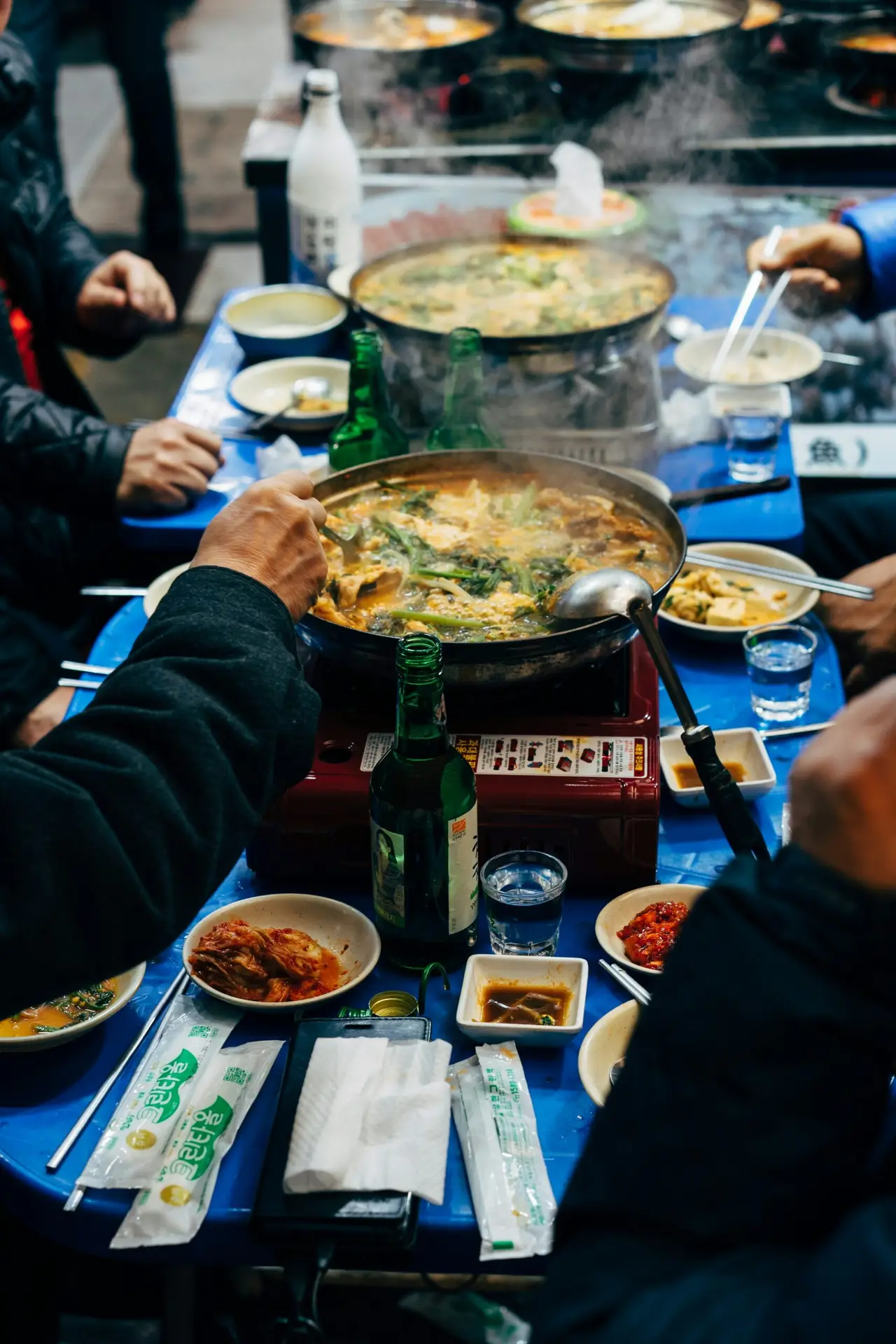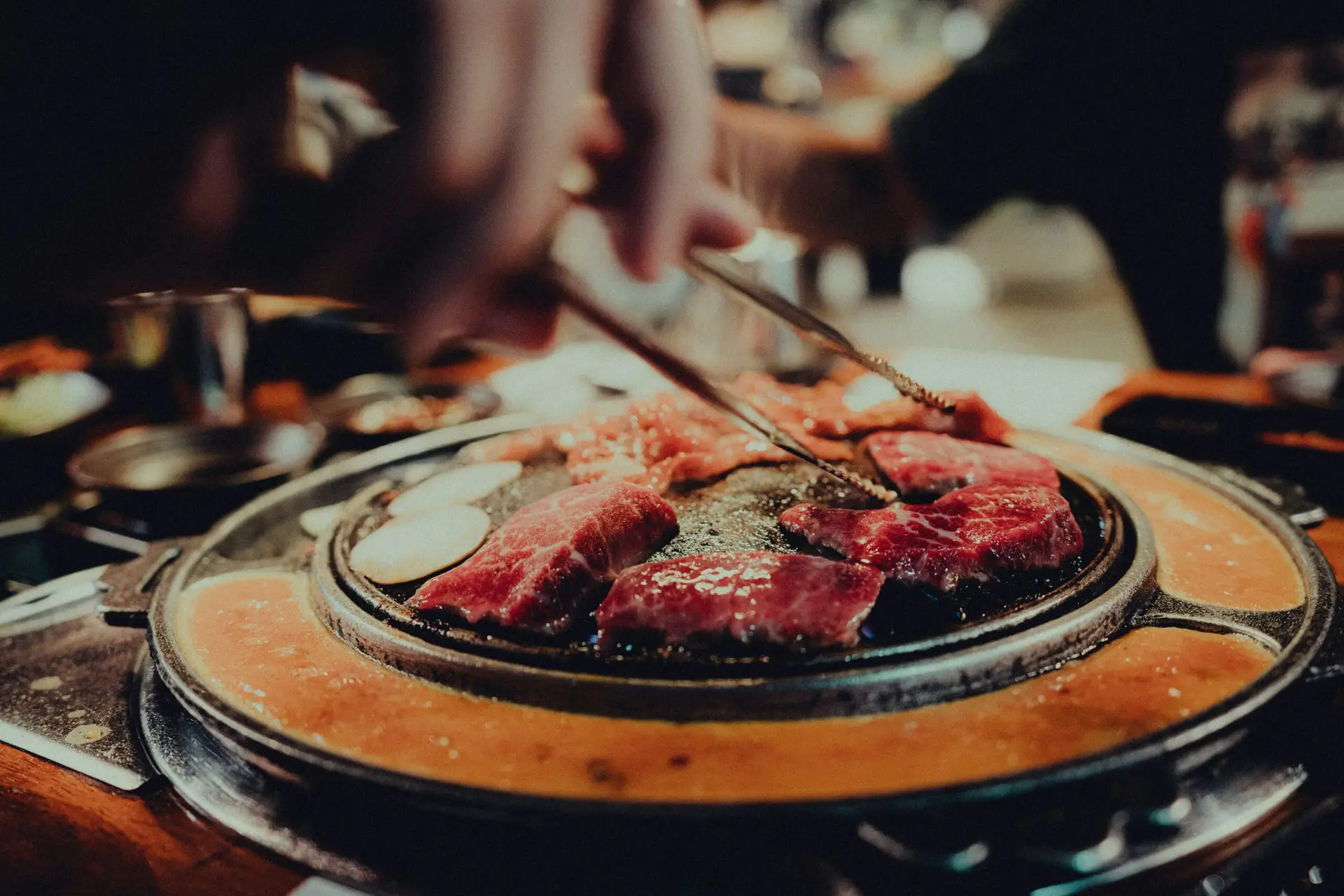First things first: Korean food is a sensory explosion. It’s a vibrant concoction of sweet, salty, spicy, and savoury flavours, mixed together with meticulous care to achieve a harmonious balance. But the magic goes beyond the taste buds. Kimchi, the fiery fermented cabbage that’s practically a national symbol, is a visual feast for the eyes with its vibrant red colour. The sizzling symphony of meats grilling at your table is an auditory delight, and the delightful array of colourful banchan (side dishes) is a feast for the eyes even before the first bite.

Forget fancy table manners – Korean BBQ is all about interaction and sharing. Cook meats and seafood at your table on a built-in grill, creating a fun and dynamic dining experience. Popular options include bulgogi (marinated beef), daeji bulgogi (spicy pork belly), and samgyeopsal (un-marinated pork belly) wrapped in lettuce leaves with sauces and banchan.
Beyond BBQ: A Culinary Adventure
Korean cuisine offers a variety of dishes for all tastes. Vegetarians will enjoy dubu jorim (braised tofu) and bibimbap (mixed rice with vegetables and egg). Don’t miss the mind-boggling array of banchan, like kimchi and japchae (glass noodles stir-fried with vegetables), that add flavour and texture to your meal.
A Guide to Korean Restaurant Etiquette
- Seating: The guest of honour traditionally sits farthest from the entrance.
- Chopsticks and Spoons: Chopsticks are for most dishes, while spoons are for soups and stews. Avoid spearing food with chopsticks.
- Ordering and Sharing: Sharing is encouraged! Dishes are often served family-style for everyone to enjoy.
Choosing Your Perfect Korean Restaurant:
- Korean BBQ Restaurants: Specialise in Korean BBQ, offering a variety of meats and seafood to cook at your table.
- Casual Korean Restaurants: Provide a relaxed atmosphere and a wider menu of Korean dishes.
- Korean Noodle Houses: Specialise in Korean noodle dishes like bibimbap and japchae.
- Fine-Dining Korean Restaurants: Upscale establishments with a refined take on Korean cuisine.
Dive into Delicious Exploration!
This guide equips you with the basics to navigate the exciting world of Korean restaurants. So dive in, explore the flavours, and enjoy the unique culture of Korean cuisine!
Unveiling Korean Delights: Drinks, Appetisers, and Beyond BBQ
Korean Drinks for Every Palate:
- Soju: A clear, distilled spirit similar to vodka, often enjoyed neat or on the rocks with BBQ.
- Makgeolli: A milky white, unfiltered rice wine with a slightly sweet and tart flavour, enjoyed slightly chilled.
- Korean Beers: Popular domestic brands like Hite, Cass, and OB Beer offer a variety of styles from lagers to pale ales.
- Korean Soft Drinks:
- Korean Pear Juice: Refreshing and sweet, perfect for pairing with spicy food.
- Korean Rice Tea (Shikhye): A traditional dessert drink with a slightly tangy and refreshing flavour.
Appetisers to Whet Your Appetite:
- Mandu: Korean dumplings filled with meat and vegetables, steamed, fried, or boiled.
- Kimchi Jeon: A savoury pancake made with kimchi and batter, enjoyed as an appetiser or part of the banchan.
- Haemul Pajeon: Seafood pancake, available in smaller portions as an appetiser.
- Tteokbokki: Spicy stir-fried rice cakes, a popular Korean street food with chewy rice cakes, gochujang (Korean chilli paste), fish cake, and vegetables.

Exploring Beyond the Grill:
Korean cuisine extends far beyond the sizzling world of BBQ. Here are a few additional dishes to explore:
- Sundubu Jjigae: Soft tofu stew, a flavourful and comforting option.
- Bibimbap (vegetarian version): A visually stunning dish featuring rice, seasoned vegetables, and a fried egg, all served in a hot stone pot.
- Japchae: Glass noodles stir-fried with vegetables, meat, and sometimes seafood, offering a delightful combination of textures and savoury flavours.
Sample Korean Meal Ideas:
- Meat Lover’s Feast: Start with Kimchi Jeon and Bulgogi or Samgyeopsal for the main course.
- Vegetarian Delight: Enjoy Dubu Jorim or a vegetarian Bibimbap with Shikhye to drink.
Common Korean Food Terms:
- Banchan (반찬): Small side dishes served with Korean meals.
- Bibimbap (비빔밥): Mixed rice with vegetables and egg.
- Bulgogi (불고기): Marinated grilled beef.
- Galbi (갈비): Marinated short ribs.
- Gochujang (고추장): Korean chili paste.
- Japchae (잡채): Glass noodles stir-fried with vegetables, meat, and sometimes seafood.
- Kimchi (김치): Fermented napa cabbage.
- Makgeolli (막걸리): Unfiltered rice wine.
- Soju (소주): Distilled spirit similar to vodka.
- Sundubu Jjigae (순두부찌개): Soft tofu stew.
- Sample Korean Meal Suggestions:
- For Meat Lovers:
- Start with Kimchi Jeon (appetiser)
- Bulgogi and Samgyeopsal (main course)
- For Meat Lovers:
- For Vegetarians:
- Dubu Jorim (braised tofu) or Bibimbap (vegetarian version) (main course)
- Shikhye (drink)
This is just the beginning of your Korean food adventure! With a variety of restaurants, dishes, and flavours to explore, Korean cuisine offers a delicious journey for all taste buds. So, grab your chopsticks and dive into the vibrant world of Korean food!






2 thoughts on “Essential Guide to Korean Restaurants 2024”
Your article helped me a lot, is there any more related content? Thanks!
I’m so glad you found the article helpful! I have more related content that you might enjoy https://goodlife-app.com/category/blogs/local-hotspots/. Let me know if there’s anything specific you’re looking for!